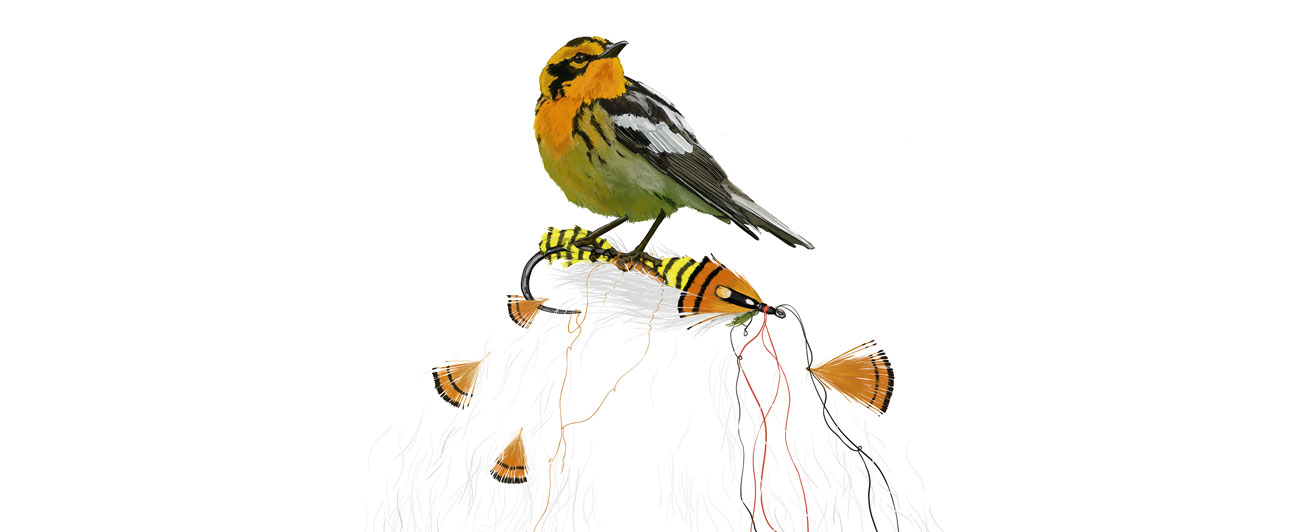Gallery
At the Confluence
Bri Dostie’s New Point of View
First published in Volume 14, Issue 1 of The Flyfish Journal
Bri Dostie lives in a confluence, a mixture of nature, art, pioneering women, community and angling, all against the backdrop of the Maine outdoors. The relationships and connections between them fuel her work, her art and her angling, and, not surprisingly, these pursuits also flow together.
Homeschooled by her mother (who she affectionately refers to as a “nature nerd”) in Greene, ME, as a child Dostie spent significant amounts of time outdoors and became interested in the wide variety of birds she saw in the woods. To better identify and spend more time with the birds, she began sketching them with pencil. Dostie’s initial forays into art were ultra-realistic interpretations, doing her best to replicate on paper the creatures she saw in the forests and on the rivers she explored.

ABOVE
A custom commission bringing together birds, fish and flies from the Northeast and the West, mixing worlds for a gift to a lifelong Mainer who’d moved to Montana. A small brook trout (native to Maine) chases a Purple Haze, a mainstay Montana dry fly. A sizable cutthroat chases a traditional Grey Ghost streamer, as if to maintain the gift recipient’s connection to home. The central bird is an eastern bluebird, which can be spotted in both Maine and Montana, flanked by a western magpie and a nutcracker.
LaCasse Custom East West
Gouache with watercolor and pen + ink on digital underpainting
16”x12”
2021
At 6 years old, she began fishing with her mother and grandfather for brook trout. As a teen, flyfishing came into focus by way of her longtime partner, Elijah Miller. Dostie began flyfishing with him and his father and found it provided her with a new perspective, as well as new challenges.
Several realizations came quickly: There was a lot to learn; learning anything from a partner can be difficult; the majority of available flyfishing education is male-authored and assumes a male audience; and perhaps most sobering, flyfishing culture can feel exclusive to those who don’t share identities with the majority. Seeking approachable mentorship and community, Dostie joined the Maine Women Fly Fishers group.
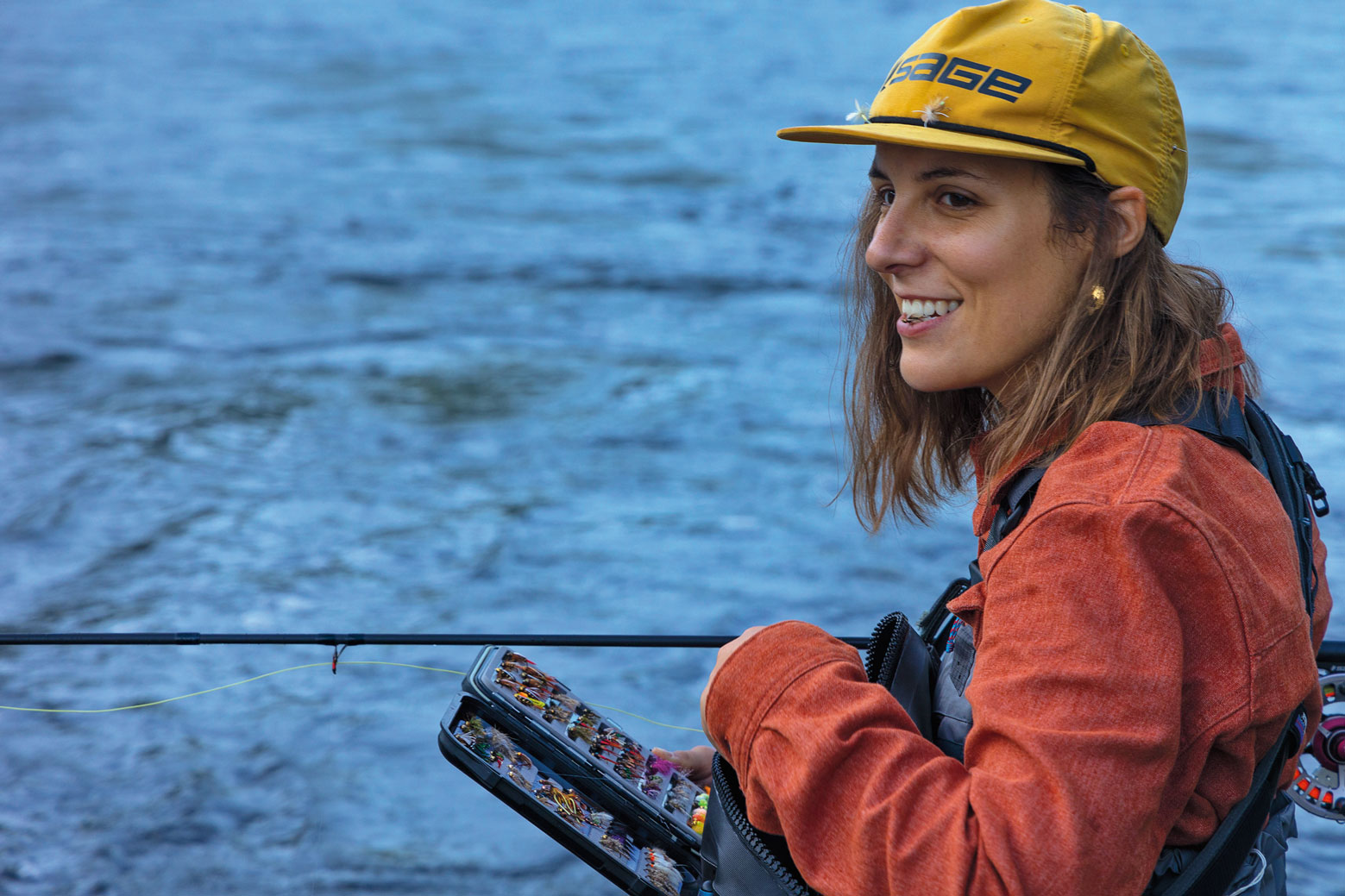
above
“Bri Dostie changes flies on a fall day on the Androscoggin River near Errol, New Hampshire. Dostie is not only a skilled angler but also a well-versed forager of local plants and mushrooms. After a day spent fishing for trout and landlocked salmon, we found mushrooms and created a riverside meal of stocked fish and fungi.” Photo: Joe Klementovich
Eventually, Dostie became aware of the rich history of female flyfishers and fly tyers in Maine. Spending time in the small, lake-centric western Maine town of Rangeley, names such as “Fly Rod” Crosby and Carrie Stevens resonated. These women made flyfishing and tying their own. They built what did not exist before: unique fishing methods and fly patterns, organizations and conservation efforts—in a much broader sense, they created entry points and avenues to flyfishing. Following in the footsteps and canoe paddle strokes of “Fly Rod” Crosby, Dostie completed the prestigious and challenging Registered Maine Guide program in 2019.
Seeing and feeling the gap in flyfishing education, Dostie began creating and building. Leaning on her art background, she developed coloring pages, diagrams and infographics to share with beginning anglers and those curious about flyfishing.
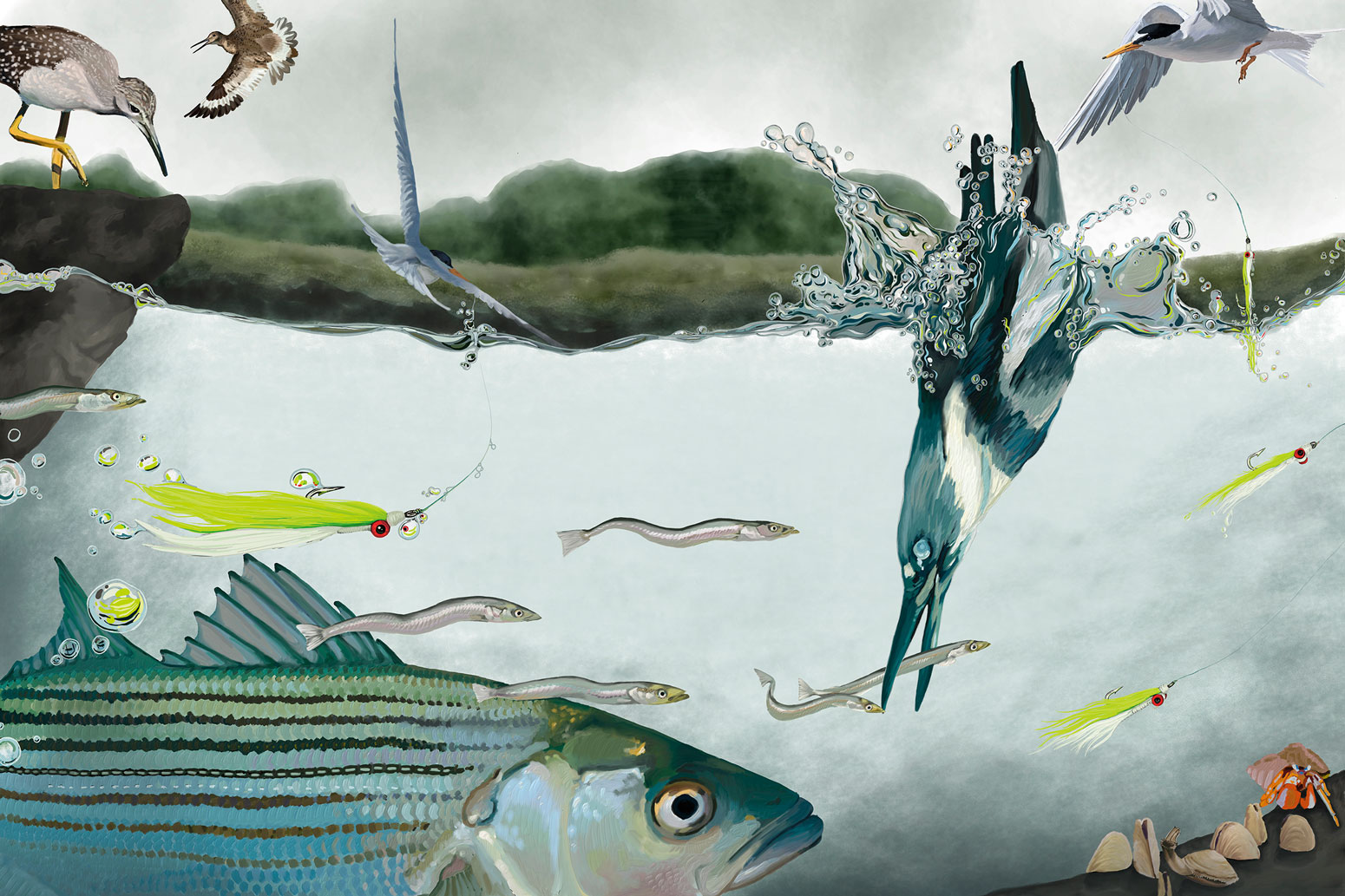
above
A custom commission celebrating the Scarborough marshes where the LaCasse family resides, and seasonal summer visitors arrive by wind and water. Here, an explosion of summertime occurs: a striper cruises below the surface over the mudflats; willets scream their song on the wind, terns dive and feed in chaos, amid chartreuse Clousers, a favorite fly of the LaCasses.
LaCasse Custom Scarborough Marsh
Gouache with watercolor and pen + ink on digital underpainting
36”x24”
2022
Her “Birds with Flies” depict seasonal Maine songbirds interacting with classic, female-tied, Rangeley-area streamer patterns. Inspired by the birds, the patterns and the tyers alike, Dostie tells a unique story with each piece, weaving together the three elements. We see a golden-crowned kinglet holding Carrie Stevens’ famous Grey Ghost, both ever-present in Dostie’s angling explorations. There’s the whistling yellow warbler with matching Canary streamer. A black-throated blue warbler carrying an unraveling Blue Devil prompts the question: Is the bird culprit or medic to this fly?
The bird-and-fly pairings are confluences in themselves—both in the stories they tell and in the process required to create each one. Beginning with digital line drawings and underpaintings, Dostie then takes her work to paper. Once printed, the pieces come to life with layers of watercolor paints and gouache. In a final step, Dostie’s artistic roots appear, as she applies pen and ink for the finest details. The finished pieces provide depth and encourage the viewer to gaze from afar and from as close as they dare. Deeper still lies an interesting play between the realistic imitations of birds and the inherently impressionistic flies they hold.
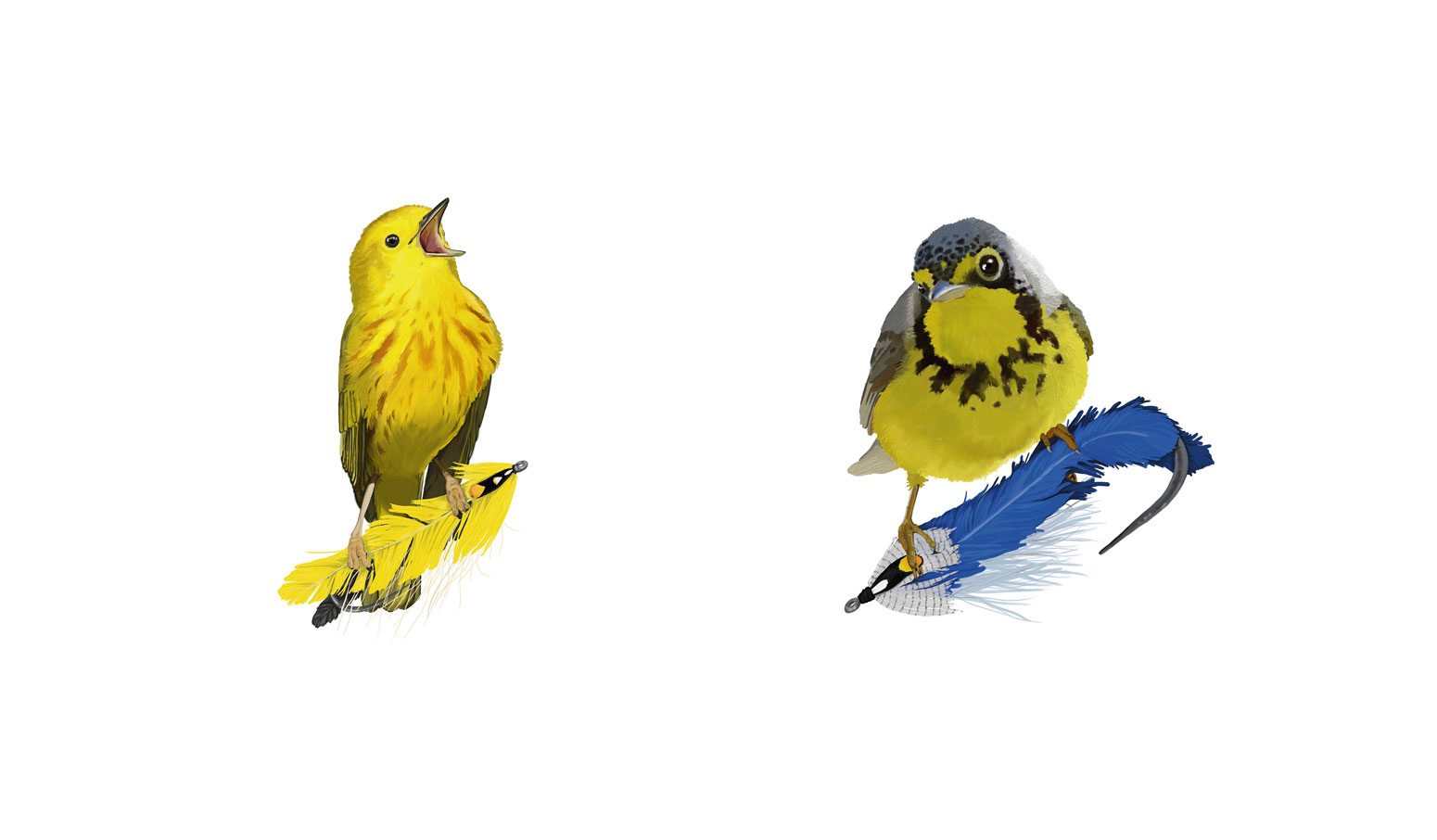
above left to right
The bright yellow warbler is typically on the move foraging in the tops of trees; the Canary streamer is grasped tightly by the singing bird, focused on the connection between bird and feathers in fly.
Yellow Canary
Gouache with watercolor and pen + ink on digital underpainting
8”x8”
2020
The Canada warbler with a blue streamer was one of the first within this series, an opportunity to play with the concept and see where it would go. The idea of a seasonal warbler in Maine that could match the bright plumage of various flies felt exciting; it provided an opportunity to highlight the interconnectivity of flyfishing.
Canada Blue
Gouache with watercolor and pen + ink on digital underpainting
8”x8”
2020
“Birds with Flies,” like Dostie’s other work, are thought-provoking. With much of today’s flyfishing media focused on the end goal of catching fish, Dostie’s art encourages anglers to consider background stories and historical context while at the same time honoring the opportunity to experience the present. It’s easy to forget that without the former, there would be no latter.
While Dostie’s educational work was well-received, studying flyfishing at home only goes so far—eventually it’s time to get on the water. Dostie began organizing group flyfishing trips designed to engender a sense of belonging. As with the pioneering work of innovative female anglers before her, Dostie sought to provide a space for intersectionality in flyfishing. This work has culminated in the Confluence Collective, a social enterprise working to remove barriers, build community, instigate change and amplify diverse stories. As a guide, Dostie enjoys taking beginners and helping them discover flyfishing through their own point of view, not an existing one.
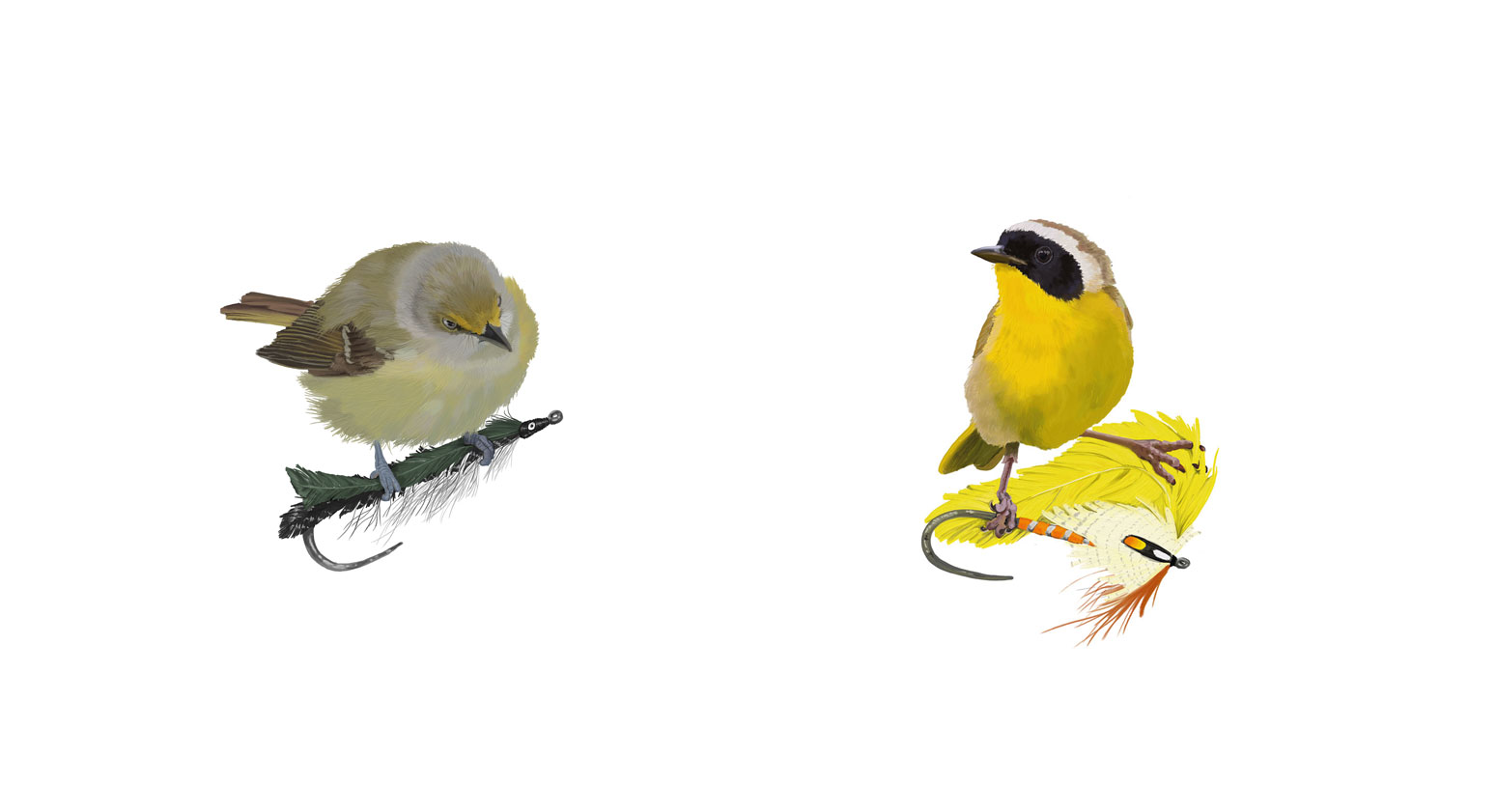
above left to right
A personal favorite of the artist, the Tennessee warbler is not a flashy one and is often missed in the vegetative mix. Here, the bird is fluffed up and angsty, holding tight to the 9’3” streamer—aptly named for the first fish it caught: a 9-pound 3-ounce landlocked salmon. The pattern has multiple claiming inventors, though Carrie Stevens was known to tie it frequently. The tight grasp and pointed gaze of the Tennessee represents the hard determination and resolute persistence required of women in any male-dominated space to know their worth, feel confident in their movements, and carry on.
Tennessee 9’3”
Gouache with watercolor and pen + ink on digital underpainting
8”x8”
2020
Yellowthroats are a familiar sign of summer, rustling among undergrowth and fallen leaves in the ground cover. Carrie Stevens designed the Colonel Bates streamer in its namesake’s honor, renaming it as he climbed the ranks; while being a quiet legend in flyfishing, she looked to celebrate and uplift those around her. This cheeky warbler is beginning to tear the fly apart, an invitation for viewers to start unpacking their own truths and assumptions about the spaces they hold, and what is hiding underneath.
Common Yellowthroat Colonel
Gouache with watercolor and pen + ink on digital underpainting
8”x8”
2020
While not the intent, it’s no surprise that Dostie’s passionate work has met with success and garnered acclaim. In 2020, she received Orvis’ Breaking Barriers Award; last year she was named one of Maine Magazine’s 2021 Mainers of the Year. Confluence Collective’s community continues to grow rapidly. The organization’s group trips, called Outcast Campouts, are fully booked, with a waiting list for next year.
Through it all there will be time in wilderness, where Dostie’s art is nourished. For an upcoming project she will paint with watercolors, drawing water and pigments from the very locations in which she finds herself. That Dostie finds herself at a confluence of nature and art is no surprise. She prefers it that way.
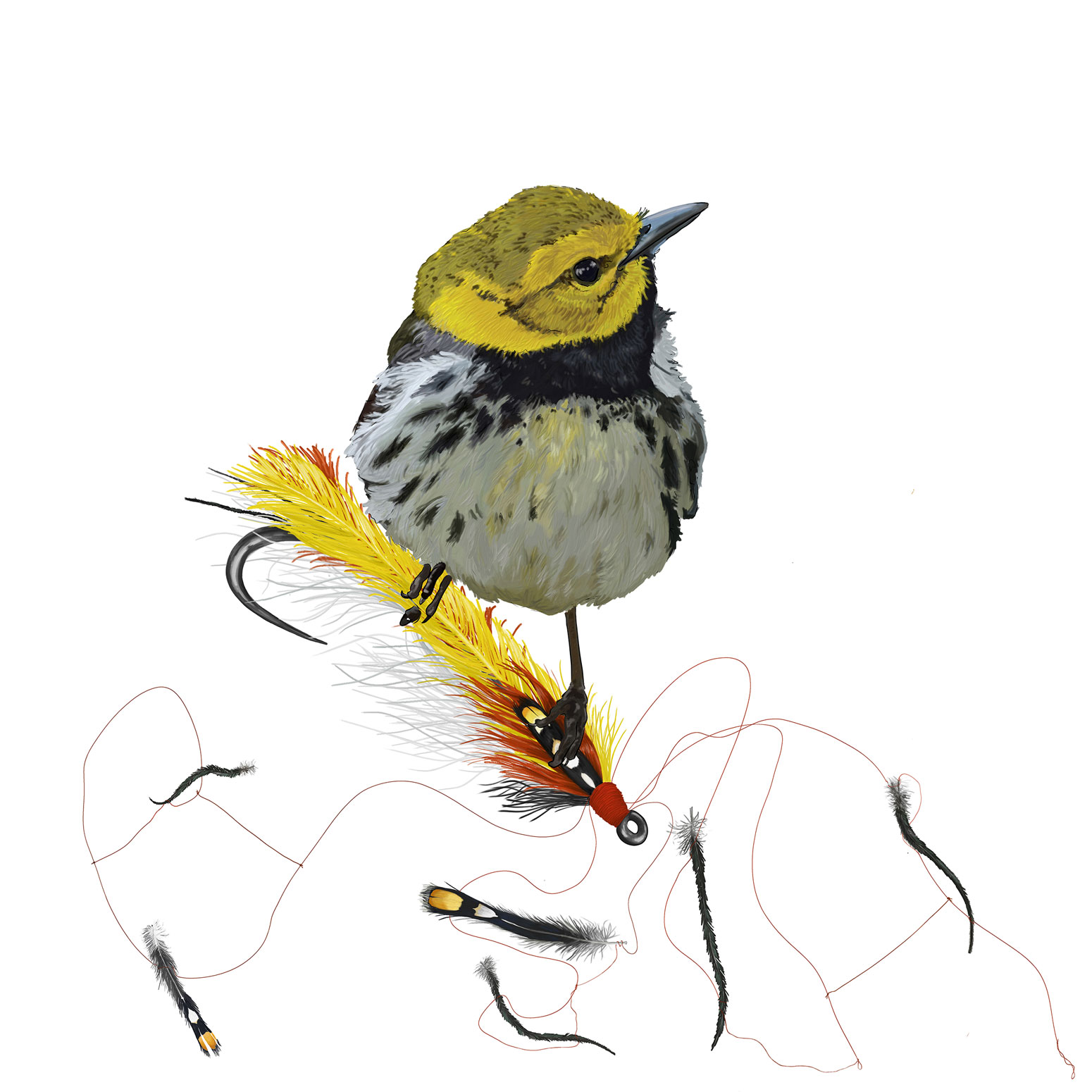
above
Carrie Stevens was known for using more affordable and accessible tying materials compared to the traditions of fancy salmon flies brought over from the United Kingdom; with the Rooster’s Regret, she names her frequent source directly in the fly. By opting for chicken feathers instead of exotics, flies became more affordable yet were still incredibly effective for Maine waters.
Black Throated Green with Rooster’s Regret
Gouache with watercolor and pen + ink on digital underpainting
8”x8”
2020
A note from the artist: These works feature Maine songbirds encountered in the woods and waters where traditional Rangeley streamer flies are used. The series focuses on flies tied primarily by Carrie Stevens, and depicts birds reclaiming the tools we use to interact with fish made from feathers that appear as if they could have been plucked from them. In total, they’re an act of many reclamations: 1. celebrating innovative women from Maine’s deep history of flyfishing in a cultural space in which they are often overlooked or missed, despite being an integral part of the places we know so well today, and 2. reconnecting tying materials with presumed sources as a reminder of the interconnected dynamics within the act of flyfishing, of all the pieces that come together to create the moments we love while on the water. The series started with aesthetic pairings—what warbler seems to match this fly?—and grew into a way to pull things apart. It’s an encouragement for anglers to consider the details of what becomes commonplace in practice, and a reminder to revisit the truths we think we know about the culture we perpetuate and belong to.
